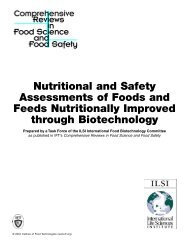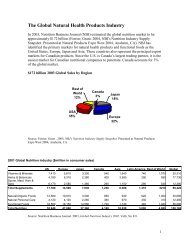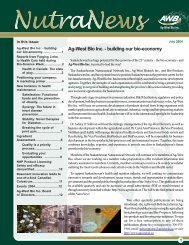Beyond Borders: Global biotechnology report 2010
Beyond Borders: Global biotechnology report 2010
Beyond Borders: Global biotechnology report 2010
You also want an ePaper? Increase the reach of your titles
YUMPU automatically turns print PDFs into web optimized ePapers that Google loves.
of the manufacturing process. And that’s what we do: take 85% of<br />
the greenhouse gases out by making these fuels from renewable<br />
resources that don’t compete with food.<br />
And, you know, in our case, sugar cane works beautifully as a<br />
feedstock just as it does for ethanol. Ultimately, this technology<br />
will be able to be run on the cellulosic sugars that are created when<br />
you can break biomass down and get the sugars out. There are<br />
many companies working on that. Once those sugars are available<br />
at cost-effective volume, we can use products other than cane juice<br />
and sweet sorghum. Our technology is feedstock-agnostic and any<br />
source of sugar works.<br />
Roe: There are really several critical components that eventually<br />
become different verticals within this industry. I think the obvious<br />
one is the feedstock materials that would be converted into fuels.<br />
There would also be the actual conversion technologies now<br />
emerging that would facilitate the conversion. You then have the<br />
owner/operator group, which may be separate and distinct from<br />
the other two. Finally, there will be the end-fuel marketers who are<br />
actually putting this fuel into the marketplace.<br />
Since this is still an early venture at this particular point in time,<br />
the evolution of these will occur somewhat piecemeal, but there<br />
would be certain advantages, obviously, in some sort of integration<br />
of these aspects. We believe there will be a shift in the overall value<br />
chain over time, along with who can extract the most value at<br />
different points in time.<br />
So ultimately, I think in a more mature market, most of the value,<br />
not surprisingly, should accrue to those who control the feedstock.<br />
That’s the way most of these types of commodity materials will<br />
work. But in the interim and in the early going, it will be possible to<br />
have value acquisition and value capture in separate parts of these<br />
verticals before it becomes entirely a feedstock game.<br />
Forer: We observe increased corporate activity in the market,<br />
and not only from the oil and gas companies. From what you<br />
have seen, what has worked in terms of partnerships? Are there<br />
any lessons learned?<br />
Mace: Everything we do in BP biofuels, we do in partnership. And<br />
certainly what we are looking for in terms of partnerships is a<br />
response to the fact that nobody knows everything about this new<br />
industry. The biofuels industry is effectively the merging of two very<br />
old and very well-established value chains. One is the agricultural<br />
value chain and the other is the energy value chain. Therefore, I<br />
don’t believe there is any operator today who can claim to have all<br />
the capabilities and all the skills and know-how to make biofuels<br />
happen on a very large scale.<br />
So partnerships are effectively a case of merging the capabilities<br />
and finding people with complementary skills who have the same<br />
vision, the same strategic objectives as you have.<br />
Roe: I would agree with what Ollie just said. And I would add that<br />
I think as we look over our shoulders and look at what might<br />
have worked in the current manifestation of biofuels, and as we<br />
look forward to what’s likely going to be involved here, it seems<br />
as though there are really sort of four fundamental areas that<br />
have to converge and to which different players and partners can<br />
bring different strengths. It’s really the convergence of people and<br />
partners who can bring together feedstock, a conversion process or<br />
technology, a distribution model into the marketplace and, fourth,<br />
and perhaps most critical at the moment, the financing that allows<br />
these other pieces to come together. In each case, in each project,<br />
in each production facility, those are the critical four pieces.<br />
So the most effective partnerships are going to be those in which<br />
the players know their respective parts and can bring one or more<br />
of those factors together.<br />
Bandak: There is absolute strategic rationale and logic to pursuing<br />
partnerships for the reasons just mentioned, especially financing.<br />
A partnership helps validate the technology in question. It can<br />
also help an early-stage company roll out its plans throughout the<br />
country, which is critically important.<br />
However, both parties need to know what they’re bringing to<br />
the table. And there need to be complementary strengths and<br />
weaknesses. And if you also think of a JV as a marriage, is there<br />
going to be an exit? If so, how? Who is the ultimate buyer? How do<br />
“If it takes us 20 to 30 years to get there,<br />
we have to start now and we have to have<br />
structures in place, including innovative<br />
financing structures, that will allow this to<br />
happen.”<br />
99








